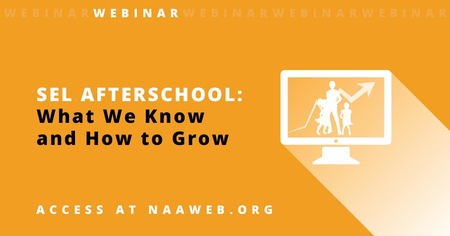Based on the Wallace Report, Navigating SEL From the Inside Out, the "Choosing SEL Curriculum for Your Program" webinar—presented by Dr. Stephanie Jones, Professor of Education at the Harvard Graduate School of Education at Harvard University, and Aimee Moody, LearningWorks AfterSchool Director—helped leaders understand the key process to find the right SEL curriculum for their programs.
The takeaways from the research done for Navigating SEL From the Inside Out, Dr. Jones explained, are vast.
Though research shows that high-quality, evidence-based SEL programs produce positive outcomes for students, not much was known about what's inside these programs that may drive these positive outcomes.
"There wasn't a lot of information out there that explicitly linked in-school SEL to, potentially, out-of-school-time SEL, so this report is the first step in doing that," said Jones, noting that the report describes the extent to which each program focuses on 12 common skills across five SEL domains, in addition to 17 instructional methods and 10 program components.
What do OST providers need to think about as they select SEL programs?
Jones explains that the report could be used to:
- Select specific programs or strategies that best align with their specific needs, goals, and resources.
- Guide planning and goal setting conversations with school and district leaders, OST partners, and other stakeholders.
- Reevaluate the fit and effectiveness of SEL programs and structures already in use.
Across all 25 programs studied in the report, Jones shared that all of the below happened:
- Structured classroom activities beyond the core lessons.
- Culture and climate supports (either suggested/structure schoolwide activities or behavior management strategies).
- Professional development (either self-facilitated or developer-led).
- Some degree of implementation support.
- Materials to actively engage family members in skill-building, more than just informational handouts.
- Skills are modeled, taught, practices and discussed.
From there, where do should you start in selecting an SEL program?
Many of the skills targeted in out-of-school-time programs, Jones explains, are also central goals of social and emotional learning programs. Careful discussion of the five key considerations below will help guide you in adopting/adapting program elements to best meet your needs:
- Expansion without standardization.
- Consistency without being redundant.
- Alignment with mission.
- Alignment with pedagogy.
- Consideration of student needs.
Once a program has considered its mission, pedagogical approach, partner organizations and student needs, the report could be used to search for appropriate SEL building blocks, in addition to providing some accompanying tools for selecting a program.
Aimee Moody, whose program has been using Responsive Classroom, shared key considerations her program prioritized when selecting the right SEL program for them.
"The number one thing we looked at was if a program was evidence-based," said Moody, who looked at LearningWorks' grant goals as a guideline. "This program in particular works well for staff because it's much more of a strategies-and-approach model versus a cookie-cutter lesson."
Moody also described why this specific approach works well for them and how she's seen students benefit due to the dedicated time SEL her program prioritizes each day.
"We have to adapt the program because I have a variety of staff with different abilities," said Moody. "It's helpful because we can be flexible, but it comes down to training."
To access the entire recording, visit SEL for Kids Starts with the Adults.



